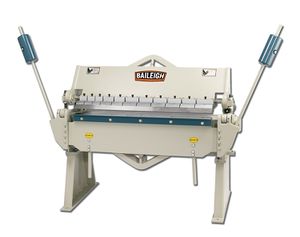Bending Brake
Revision as of 18:35, 17 April 2019 by Nbloomquist17 (talk | contribs)
A bending brake is a metalworking machine that allows the bending of sheet metal. The brake in the shop is a Chicago W31 steel box and pan brake. In a box-and-pan brake (also known as a finger brake), the clamping bar includes several removable blocks, which may be removed and rearranged to permit bending of restricted areas of a piece of sheet metal or of already partially formed pieces. After bending, a box or pan form is then completed by screw, solder, weld, rivet, or other metal fixing process.
The current Ace of the Bending Brake is Nathan Hayward (nhayward21@georgefox.edu).
Resources
Training
Bending Steps
- Ensure that your sheet metal is thinner or equivalent to 14-gauge sheet metal, and ensure that it is less than 48" in width.
- If making a bend for a box or a pan, adjust the fingers so that the equivalent width of the fingers is just shorter than your sheet metal.
- Adjust the clamping force and the clamping handle to allow room to insert your work piece.
- Insert your work piece to the line you want to bend, centered in the brake, and clamp your piece securely.
- Pull up on the bending handle of the leaf slowly until your piece is bent to the desired angle, and slowly lower the leaf.
- If the piece does not bend straight, unclamp the handle on the overbent side and adjust the top leaf.
- Adjust the clamp handle, and remove your piece.
- Put back any fingers if adjusted, and deburr if any rough edges are left.
3 commandments
Stuff about the 3 commandments.
Safety First
- Always make sure your hands are out of the way of the fingers and all moving parts.
- Be aware of your surroundings to ensure that you do not bump others with the counterweight.
- If bending a small piece of metal, place it in the center of the brake.
- You may not use the sheet metal machines without safety glasses!! (Should be obvious if you are following the rules of the shop)
